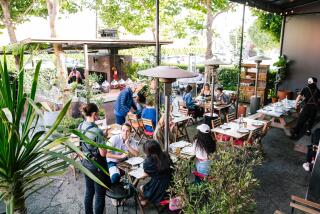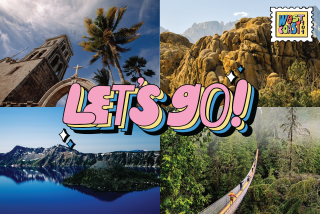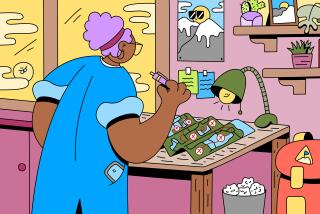Resort Town of Ascona Is a Swiss Garden Spot
- Share via
ASCONA, Switzerland — France has its St. Tropez, Italy its Positano and Spain its Marbella, but when well-to-do Swiss and many other fashionable Europeans want ideal weather, lots of palm trees, flowers and blue water outside the front window, they head for this garden spot on the northern shore of Lake Maggiore in the Italian-speaking canton of Ticino.
Old stone homes and farmhouses of Ticino are quite different from those made primarily of wood farther north in rural Switzerland. Roofs are usually of Italian tile or slate, walls often three feet thick and, in the absence of inside stairways, traffic between stories is by outdoor stairs and galleries.
Ascona’s ideal climate drew inhabitants from the south as early as 800 BC, but it remained a simple fishing village until early in the 20th Century. That’s when an influx of “naturists” from countries in Northern Europe began arriving. They were strict vegetarians who sought a simple and austere life on a nearby mountain.
That first cadre soon attracted others interested in the same life style, or simply curious, and a tourist industry of sorts was born, growing by great leaps every year.
Today’s visitors, after walking Ascona’s cafe-lined lake front and narrow streets festooned with flowers and pricey shops or they can visit the simple cabins of those early naturists. The life-style choice is then up to them, with most choosing the former.
Getting here: Fly American, Pan Am or TWA to Zurich, Balair through October when Swissair begins nonstop Los Angeles-Zurich service. From Zurich to Ascona you’ll see much of Switzerland in 3 1/2 hours of a scenic train ride, using a Swiss Pass that lets you ride trains, buses, lake steamers and city trams all over the nation. The Zurich train arrives in Lucarno, separated only by a river from Ascona and a five-minute cab or bus ride from the station.
How long/how much? For sights within this town of only 5,000, a day or two will do it. But please allow time for boat rides along Lake Maggiore. Ascona’s hotels are moderately priced, dining the same.
A few fast facts: The Swiss franc recently sold at 61 cents each, about 1.6 to the dollar. Weather from late spring through fall is marvelous, but during July and August the town turns into “people city.” No problem at all to walk anywhere in the village.
Getting settled in: Romantik Hotel Tamaro (on the lake; $85 to $128 double with huge buffet breakfasts) is a 16th-Century patrician home very much in the Mediterranean style, built around a central patio dining room loaded with vines and flowers. Bedrooms are beautifully decorated, with TV, mini-bar and lake-side rooms with balconies.
On the roof you’ll find a sunny terrace with more flowers, views of the lake, mountains and islands. The dining room is exquisite, the food excellent.
Hotel Riposo (middle of town, a minute walk to the lake; $107-$124 double with half-pension) is another old Ticinese home renovated into a fine hotel. Riposo has a tiny inside courtyard awash in flowers, roof garden with pool, more flowers and views of lake, plus a rustic grotto bar with occasional music at night.
Bellaria (Via delle Cappelle; $123 double, half-pension) is a modern hotel set beside vineyards yet a short walk from the lake and main piazza. There’s a huge lawn and heated pool, sauna, most bedrooms of moderate size with contemporary furnishings in cool pastels, some with balconies.
Regional food and drink: Nearby Italy’s influence is strong on Ascona’s tables, to the point of domination. Try the minestrone ticinese , or with tripe added, busecca . Trota in carpione is trout marinated in red wine and vinegar and served as a cold hors d’oeuvre.
Pork is a staple here, particularly in the wonderful salamis, salametti and mortadella. It is also combined with cabbage in the Ticinese dish cazzola. Surrounding mountains provide plentiful game, and piora (a small cheese eaten with oil and pepper) often ends a meal. Or you may choose the local torta de pane , a semi-sweet bread with nuts.
Ticino’s excellent Merlot red wines are reasonably priced, as are most Italian wines, but some of the Swiss bottles are outlandishly expensive.
Good dining: One of the many joys of dining in Ticino is to have a meal in a simple grotto. These rustic places, usually set within or beside rocky mountain caves, almost always have authentic local dishes often prepared on an outside grill. We had a pleasant lunch at Grotto della Fontana (on Monte Verita) of wild rabbit ragout prepared with tons of garlic. Or you may have a daily menu such as salami, roast chicken, potatoes and salad for $6.75, which you consume at granite tables under the trees.
“Anche Vivere e un Arte” (to live is also an art) is the motto inscribed over an archway in Ristorante Borromeo (town center), and nothing could describe it better. You’ll dine in a garden under wisteria vines or in one of several vaulted and crowded rooms, all seemingly filled with convivial diners who appear very much at home.
We had both the osso buco (veal shank with mushrooms) and saltimbocca (thin slices of veal, ham and fresh sage leaves) with soup, salad and dessert for $13.50 each. It was probably the most enjoyable and satisfying meal of our Ticino visit.
Caffe Otello (beside tourist office) is a creperie that also serves light food, soups, sandwiches and salads. The first room is a coffee bar, then a small restaurant with a sunny garden and tables out back. You’ll find an excellent salad Nicoise here, along with toasted panini (small open sandwiches) of prosciutto and cheese, perhaps mozzarella, tomatoes and anchovies.
Going first-class: Giardino (Via Segnale; $268-$305 double, half-pension) is relatively new, but its low, arcaded buildings and absolutely magnificent gardens appear to have been in place forever. It’s a five-star hotel with a two-Michelin-stars dining room. Everything about the place exudes elegance.
Have a champagne buffet breakfast in the gorgeous dining room or Swiss breakfast in your bedroom, then while away the time at the pool, with tennis, golf, sightseeing in town or just sitting by garden ponds filled with goldfish and lotus blossoms of pink and white.
Aphrodite, the goddess of love and beauty whose statue is in the garden, is the patroness of Giardino, and her touch is everywhere.
On your own: This part of Switzerland has always been noted for its architects and builders, who designed the Kremlin towers and much of Leningrad for Peter the Great. Their fine work is all over this small town.
Start with the 14th-Century church of Santa Maria Misericordia, with its marvelous frescoes depicting scenes of the Old and New Testaments and the adjoining cloisters of Collegio Papio. Ascona is famed for its cultural events, with concerts and recitals held in both the church and cloisters from August through October.
Painters have always been drawn to Ascona by its wonderful light, and the town is still loaded with ateliers and galleries. And as we’ve said, the shopping is great here.
For more information: Call the Swiss National Tourist Office at (415) 362-2260, or write (260 Stockton St., San Francisco 94108) for a brochure on Ascona with a map and hotel listing, another on Ticino, plus information on the Swiss Pass transportation card. Ask for the Ascona package.
More to Read
Sign up for The Wild
We’ll help you find the best places to hike, bike and run, as well as the perfect silent spots for meditation and yoga.
You may occasionally receive promotional content from the Los Angeles Times.






